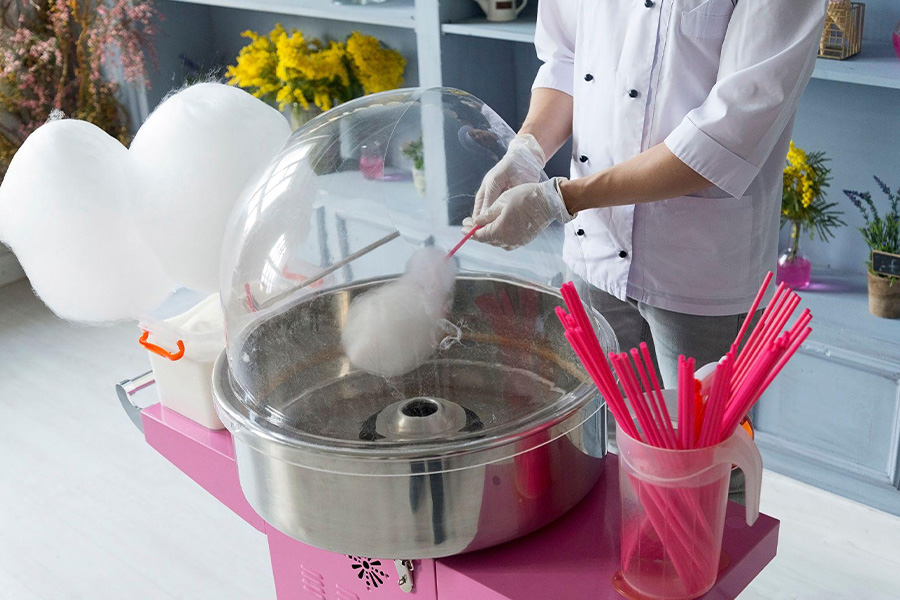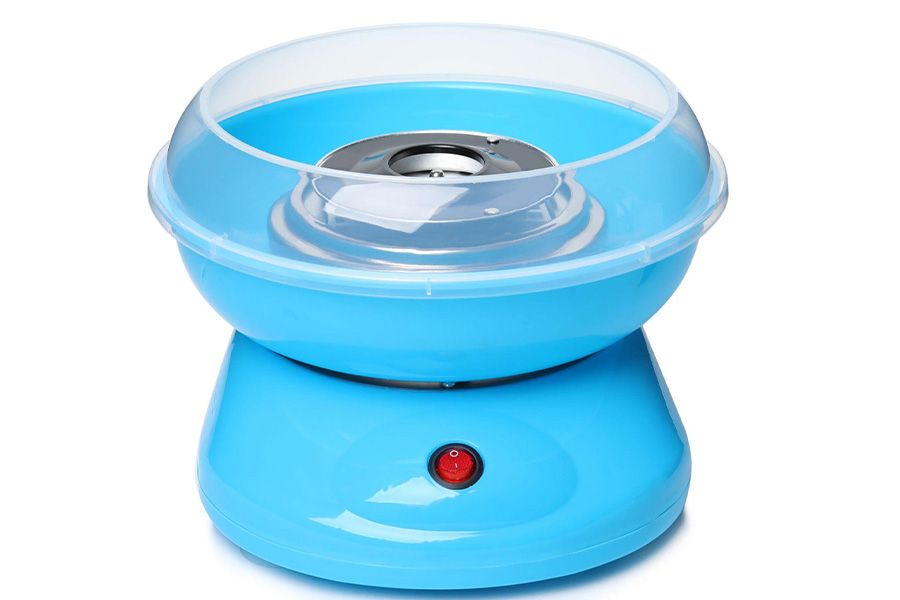Cotton candy, also known as candy floss, is a great treat that can evoke a nostalgic memories of childhood. It comes in a variety of appealing flavors, such as grape, strawberry and even milk.
The growing global market for this classic sugary treat has led to the availability of many kinds of machines. However, selecting the perfect machine may seem like a difficult task. This guide aims to help buyers find the best quality machines, in order to simplify the process of entering this fun market.
Table of Contents
Cotton candy machine market overview
Tips for buying a cotton candy machine
Types of cotton candy machines
Where to sell cotton candy machines
Take away
Cotton candy machine market overview
The cotton candy machine market is seeing worldwide growth. In 2020, the market was valued at approximately 23.25 billion USD, and the market is projected to grow exponentially with a compound annual growth rate (CAGR) of 7% over the next 30 years.
By region, the USA, China, Russia, India, and Germany are the largest contributors to the cotton candy machine market. This is because they account for almost half of cotton candy consumption worldwide.
In terms of age group, buyers are likely to be focusing on Millennials and younger generations, with sugary treats being a staple in the lifestyle of teenagers.
Tips for buying a cotton candy machine
Here’s what to look for when shopping for the best cotton candy machines:
Price
Cotton candy machines come at various prices. Small and less sophisticated units are on the lower end of the spectrum, retailing for a couple of dollars per piece, and are favorable for domestic consumption.
On the other end, large, automated machines are priced significantly higher, coming in at thousands of dollars. These machines meet the demand of customers looking to start a large-scale cotton candy business.
For those looking for something in the middle, you can also find more affordable medium-sized machines. They bridge the divide between small and large machines while coming with a multitude of features for diverse uses.
Size of the machine

The cotton candy market is supplied with an array of machines coming in different sizes. Tabletop or compact machines are the smallest and weigh less than 50 pounds. They lack wheels but have cushioned legs to hold the machine stably as the motor spins.
Cart cotton candy machines are slightly larger. They are mostly used at carnival fairs, street corners, and near shopping malls. They have wheels for easy portability, as well as ample storage space and removable parts. A typical cart cotton candy machine weighs more than 50 lbs. And as far as entertainment is concerned, they are the best for supplying candy floss at parties or once-off events.
Commercial cotton candy machines, on the other hand, are larger, heavier, more complex to operate, and immobile. They are designed to stay in the same space for months and work remotely with little human intervention. Their size and weight, which is up to 1000 lbs, and high price tag limits their market scope. Nonetheless, for those interested in large scale retail, they provide the most efficient and reliable solution.
Bowl size
The bowl size determines the size of the cotton candy that a machine can produce. Manufacturers use a bowl’s diameter in inches as its size. Machines with a larger bowl are suitable for retail oriented candy floss businesses. Commercial cotton candy machines usually have a bowl size with a diameter of more than 20 inches across, providing enough room to produce larger flosses.
Smaller models of candy floss machines are more suitable for entertaining or selling at special events or markets, and they tend to come with bowl sizes measuring between 14 and 20 inches.
Materials
Cotton candy machines are made of various materials for durability, food safety, and design. The motor and its casing are molded from stainless steel, aluminum, or high-quality plastics. These are strong materials that will last long, provided the machine is well taken care of.
The bowl is typically a thin sheet of polishable and rustproof stainless steel or aluminum. Working with cutlery-grade materials reduces the burden of cleanliness and the risk of contaminating food. When polished, a steel bowl is immaculate.
The outer casing of a machine contains steel, aluminum, glass, or plastic parts. Glass is common in commercial machines, which allows customers to see the tasty action taking place inside the machine. Steel and aluminum, on the other hand, protect fragile components against impact.
Motor speed and power
The motor speed and the power of the motor are very important when sourcing the most suitable type of cotton candy machine. Generally, machines have motors with speeds of over 1000 rpm and operate with heating power of over 35 and 1000 W, respectively. Commercial machines, on the other hand, have powerful motors that can spin up to 5000 rpm to produce nano-size candy strands.
Production capacity
The size and complexity of a machine determines the production capacity. For instance, a small compact machine can yield one serving in less than 30 seconds.
Industrial machines, on the other hand, can churn out one medium-sized candy per second. However, this is also influenced by the size of the cotton candy, and naturally, larger candies would take more time.
Types of cotton candy machines

The cotton candy market is well supplied with various designs to meet different market niches, and they can be purchased to match different power sources. Here are some of the models that are set to be popular this year and beyond:
Gas cotton candy machine
A gas cotton machine runs on two sources of heat. A propane gas cylinder provides heating energy to melt down sugar while the motor runs on standard 120/ 240 V sockets or rechargeable li-ion batteries.
Highlighted features
- The sugar dispenser rotates smoothly and quietly
- The machine is portable, thanks to less sophisticated components
- Has durable heating elements
- Some machines are powered by batteries
Pros
- They are cheaper in terms of energy investments and purchasing costs
- They last longer
- They are versatile
Cons
- A battery-powered motor is slow and inefficient
- A gas cylinder makes the machine heavy
Electric cotton candy machines

Electric cotton candy machines are the most popular thanks to their versatility, portability, and ease of use. The market offers a number of brands compared to gas or commercial machines. They work exclusively on electricity sourced from batteries or electrical grids.
Highlighted features
- Some have wheels for improved mobility
- Sturdy and reliable aluminum bowels
- Efficient motors with a power rating of over 1000W in commercial machines
- Adjustable melting temperature ranges
- Built-in fuse for safety
Pros
- Efficient and high-speed motors that can reach 5000RPM
- Long-lasting steel bowls
- Some machines may run on batteries in case of a power outage
- Suitable for commercial customers
Cons
- Commercial electric machines may be expensive
- Only a handful of models are equipped with the melting temperature adjustment feature
Commercial cotton candy machines
These are the most professional option when it comes to making candy floss. Commercial cotton candy machines have an impressive lineup of features, perform better, and can produce different flavored flosses, and even marshmallows, with a simple press of a button.
Highlighted features
- Have touch screens for placing orders
- A robotic arm collects and dispenses candies
- Operate wirelessly
- Most of them are fully automated
- Accepts coins, notes, and cards
- Equipped with a GPS
- Smart heating burner
- Real-time monitoring system
Pros
- Multiple color options to select from
- Fast and efficient. Some take less than 90 sec to produce one candy
- Different candy designs, colors, and shapes for customers to choose from
- Customized marketing ads can be displayed on the screen
- Operates both indoors and outdoors
Cons
- Cumbersome and heavy, with some weighing over 300kg
- Expensive
- The machine requires specific calibrations depending on the region
Industrial cotton candy machine
Industrial machines are similar to commercial cotton candy machines, but industrial machines can be found in a variety of different sizes, and have more room to be optimized for the businesses specific needs.
Highlighted features
- Fault feedback
- Water management systems
- Coupon setting
- Stock trackers
Pros
- Works in extreme conditions
- The machine is protected with AI features
- Easy to use
- Freedom to choose from many different colors
- Easy to clean detachable parts
- Multiple payment options
Cons
- Expensive
- Machine depreciates quickly
Where to sell cotton candy machines
The love for sugary treats is not fading away any time soon, and neither is the demand for cotton candy machines. Sellers focusing on Asian, European, and North American markets are likely to enjoy a steady demand for their products.
In Europe, Germany, Russia, and the UK are the largest consumers of candies per capita and present profitable opportunities for cotton candy machine sales.
By volume, the USA is the largest consumer of candies and also presents a great opportunity for cotton candy machine sellers. Generally, the culture of many Americans which involves eating candy at various events as well as Halloween parties is a key driver for the demand of candy floss machines.
The Asian market is also growing steadily, and worldwide, China is the second largest consumer of candies. In 2016, the country consumed over 4 million pounds of candy.
Take away
When selecting cotton candy machines, considering the price, bowl size, motor speed and power and production capacity will point you in the right direction. Such features determine how fast, efficient, durable, and reliable the machine will be.
The choice of machines may also vary between gas, commercial, industrial, and electric models. The latter, that is electric models, tend to be the best choice as they come packed with great features.
For those who want to know more about candy floss machines, or who are interested in branching out to supply some great models, check out these candy and snack packages that customers are likely to love this year.




